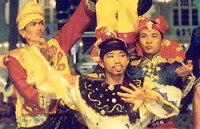
Photo.
Men dancing in Penang (Per Henriksen, Reiseliv - www.Reiseliv.no -
one of our freelance journalists and an great adventurer from Norway).
Based on
information from Nation.com (www.Nation.com),
George Town is the
capital city of the state of Penang in
Malaysia.
It's named after King George III of Great Britain.
The city is
located on the north-east corner of Penang
Island and has
about 220,000 inhabitants. Including the totally 400,000 people live there.
As the story is
told, George
Town was founded in 1786 by
Captain Francis Light. He was a trader for the British East India Company, which
used the city as a base for the company in the Malay States.
Francis Light
obtained the island of
Penang from the
Sultan of Kedah and built Fort
Cornwallis on the north-eastern corner of the island. The
fort became the nexus of a growing trading post and the island's population
reached to 12,000 in 1804.
George
Town was given
city status on 1
January 1957, by a royal charter of Queen
Elizabeth II of the United Kingdom.Due to strict
rent controls, George
Town retains many colonial-era
shophouses to this day and is often considered an architectural gem. Most of
George
Town's population is of Chinese
origin.
Stein Morten Lund, 1 May 2004
Additional information
Penang has a variety of religious structures,
from churches and mosques dating back the early 1800's to Hindu temples,
Buddhist watts, and Chinese worship houses paying mixed homage to Taoism,
Confucism, and Buddhism.Penang
is well covered with religion; whether you are an interesting in the island's
religious past, preying, or just want to have fun at the beach,
Penang is
the place for spiritual experiences.
Facts about
Malaysia:
Formal country
name: Federation of Malaysia.
Area: 329,750 sq
km.
Population: 23
million.
People: 50%
Malay, 33% Chinese, 9% Indian, plus indigenous tribes such as Orang Asli and
Iban.
Language: Malay,
English, Tamil.
Religion: 52%
Muslim, 17% Buddhist, 12% Taoist, 8% Christian, 8% Hindu, 2% tribal.
Government:
constitutional monarchy.
For more
information:
Malaysia
Tourism Promotion Board, or Tourism Malaysia: tourism.gov.my
Malaysia Tourism Centre (MTC)
109, Jalan
Ampang,
50450
Kuala
Lumpur
Tel : 03- 2163
3664/2164 3929
Fax : 03- 2162
1149
www.mtc.gov.my
Source:
World Heritage
Centre
UNESCO,
Paris
(July
2003)
Malaysia has
two places listed on the World's Heritage list:
Kinabalu
Park (N
ii, iv/ 2000):
Kinabalu
Park, in the
State of Sabah on the northern
end of the island of
Borneo, is
dominated by Mount
Kinabalu (4,095
m), the highest mountain between the Himalayas and
New
Guinea. It has a very
wide range of habitats, from rich tropical lowland and hill rainforest to
tropical mountain forest, sub-alpine forest and scrub on the higher elevations.
It has been designated as a Centre of Plant Diversity for
Southeast Asia and is exceptionally rich in species with examples of flora from the
Himalayas, China,
Australia,
Malaysia, as
well as pan-tropical flora.
Gunung
Mulu
National
Park (N i, ii, iii, iv/
2000):
Important both
for its high biodiversity and for its karst features,
Gunung
Mulu National
Park, on the
island of
Borneo in the
State of Sarawak, is the most
studied tropical karst area in the world. The 52,864-ha park contains 17
vegetation zones, exhibiting some 3,500 species of vascular plants. Its palm
species are exceptionally rich, with 109 species in 20 genera noted. The park is
dominated by Gunung Mulu, a 2,377 m-high sandstone pinnacle. At least 295 km of
explored caves provide a spectacular sight and are home to millions of cave
swiftlets and bats. The Sarawak Chamber, 600 m by 415 m and 80 m high, is the
largest known cave chamber in the world.
